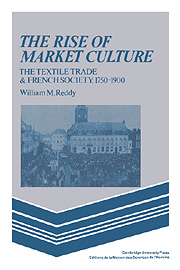Book contents
- Frontmatter
- Contents
- List of figures and maps
- List of abbreviations
- Preface
- Introduction
- Part One A world without entrepreneurs, 1750–1815
- 1 Commerce as conflict
- 2 The design of the spinning jenny
- 3 New terms and old practices
- Part Two Uses of the market idea, 1816–1851
- Part Three Unquestioned assumptions, 1852–1904
- Conclusion
- Notes
- Bibliographical note
- Index
3 - New terms and old practices
from Part One - A world without entrepreneurs, 1750–1815
Published online by Cambridge University Press: 30 September 2009
- Frontmatter
- Contents
- List of figures and maps
- List of abbreviations
- Preface
- Introduction
- Part One A world without entrepreneurs, 1750–1815
- 1 Commerce as conflict
- 2 The design of the spinning jenny
- 3 New terms and old practices
- Part Two Uses of the market idea, 1816–1851
- Part Three Unquestioned assumptions, 1852–1904
- Conclusion
- Notes
- Bibliographical note
- Index
Summary
The Revolution brought disaster to the French textile trade in every imaginable form: currency disorders, radical changes of fashion in clothing, loss of foreign customers, severe raw material shortages. Hundreds of thousands of cottagers were forced to abandon the trade; bankruptcy swallowed up hundreds of merchant houses. In another sense, however, the Revolution brought the trade just what it needed, an extended respite from direct competition with England. The impact of the new English machinery had been painful; now it was withdrawn – but not forgotten. The new mode of production continued to make its influence felt on thinking, but not on prices. Recovery and response became possible.
The response on one plane at least was not long in coming. A direct result of the reforms of 1789 was the creation of a legal foundation for entrepreneurial control within French industry. The new law of property gave producers absolute and unlimited control over use and exchange of their stock and equipment. Clarification of this law required the National Assembly to define and regulate labor for wages as the free exchange of a commodity for a price. In law, therefore, by the end of 1791, anyone who operated a production process had the power of an entrepreneur over the process and purchased labor from competing individuals as one factor of production among others.
It is important to realize, however, that these reforms bore no simple relationship to existing economic practice; there was no industrial capitalism in embryo straining to be free, no entrepreneurial class lobbying for its interest in the Tennis Court or on the night of 4 August.
- Type
- Chapter
- Information
- The Rise of Market CultureThe Textile Trade and French Society, 1750–1900, pp. 61 - 86Publisher: Cambridge University PressPrint publication year: 1984



